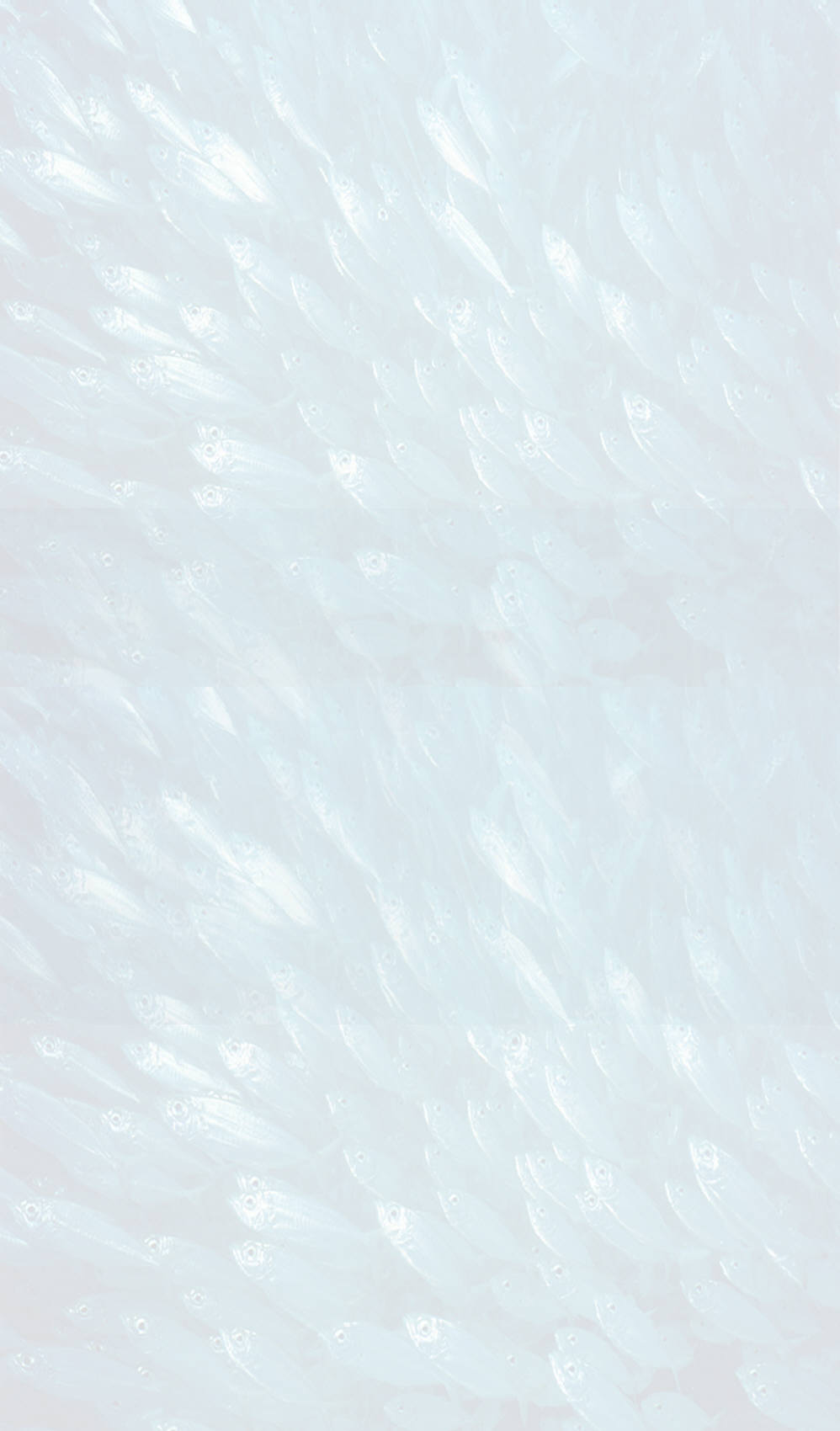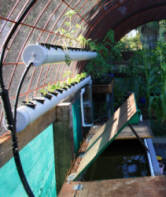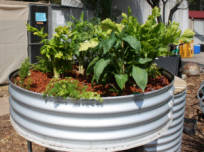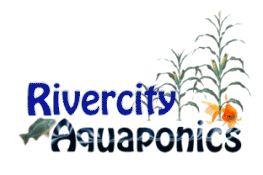
Fish Culture
The following water quality parameters are typically of highest importance to
freshwater fish being raised under aquaculture conditions:
* Water temperature
* Dissolved oxygen (DO) is the amount of oxygen (O2) dissolved in water and is measured in units of percent saturation or parts per million (ppm).
* pH is a measure of how acidic or basic the water. pH ranges from 1 - 14. A pH of 7 is neutral, below that is acidic, above that is basic.
* Buffering capacity or alkalinity refers to water's ability to keep the pH stable
and is highly dependent on the amount of minerals dissolved in the water.
* Ammonia is the first product in the nitrogen cycle (Figure 1). In water it exists in two forms and together is known as Total Ammonia Nitrogen (TAN) and measured in units of mg/L or ppm. The two forms of ammonia are unionized ammonia (NH3 or UIA) and ionized ammonia (NH4 + ). You should learn the differences between the two forms of ammonia because it is the unionized
ammonia (UIA) that is most toxic to fish. Which form of ammonia is present in water is highly dependent on both temperature and pH.
* Nitrite is the second product in the nitrogen cycle. Nitrite is a highly toxic substance that is produced by the oxidation of ammonia by bacteria. It is converted to the nontoxic form nitrate with biological filtration and measured as total nitrite or nitrite-nitrogen, dependent on the water chemistry test kit, in units of mg/Liter or parts per million (ppm).
* Nitrate, the final product in the nitrogen cycle, is usually not measured in an aquaculture setting as it is generally not toxic to freshwater fish and aquaculture test kits often do not carry the reagents to measure it.
Plant Culture:
Sixteen chemical elements are known to be important to a plant's growth and survival. The sixteen
chemical elements are divided into two main groups: non-mineral and mineral.
The non-mineral nutrients are: hydrogen (H), oxygen (O), & carbon (C) and these nutrients are found in the air and water. In a process called photosynthesis, plants use energy from the sun to change carbon dioxide (CO2) and water (H2O) into starches and sugars. These starches and sugars make up the plant's food.
The 13 mineral nutrients, which normally come from the soil, are dissolved in water and absorbed through a plant's roots. Not all of the mineral nutrients are routinely measured but are being presented to raise awareness of the essential elements necessary for plant growth. For a modest fee, the full spectrum of minerals from a water sample can be obtained by submitting sample(s) to an agricultural diagnostic service.
In an aquaponic setting, the majority of these mineral nutrients result from by-products excreted by the fish. These mineral nutrients are divided into two groups: macronutrients and micronutrients.
The macronutrients, required in large quantities, are:
* Nitrogen (N) - part of all living cells and a necessary component of all proteins.
* Phosphorus (P) - an essential part of the process of photosynthesis and in the formation of all oils, sugars and starches.
* Potassium (K) - helps in the building of protein, photosynthesis, fruit quality and reduction of diseases.
* Calcium (Ca) - an essential part of plant cell wall structure and the transport and retention of other elements.
* Magnesium (Mg) - part of the chlorophyll in all green plants that is essential for photosynthesis.
* Sulphur (S) - essential for the production of proteins
Micronutrients, essential for plant growth but needed in small (micro) quantities are:
* Boron (B) - aids in the production of sugar and carbohydrates.
* Copper (Cu) - important for reproductive growth in plants.
* Iron (Fe) - essential for formation of chlorophyll.
* Chloride (Cl) - aids in plant metabolism.
* Manganese (Mn) - functions with enzyme systems involved in breakdown of carbohydrates, and
nitrogen metabolism.
* Molybdenum (Mo) - helps in the use of nitrogen.
* Zinc (Zn) - essential for the transformation of carbohydrates.
Testing your Aquaponic System Water:
In aquaponic systems, the ultimate source of both macro and micronutrients is fish food. The consumed food provides fish with energy and the essential building blocks for growth. The digestion and metabolic processes create waste products that are excreted via the fish's gills and digestive tract directly into the water. These waste products primarily consist of carbon dioxide and nitrogenous compounds, such as ammonia.
In order to sustain a healthy environment, these substances must be removed from the aqueous environment. Most of the carbon dioxide is eliminated through aeration at the water surface and taken up by plants. The toxic nitrogenous compounds are converted to less toxic compounds via the nitrogen cycle (Figure 1). A group of bacteria known as nitrifiers (e.g.Nitrosomonas and Nitrobacter) transform toxic ammonia into nitrite and then to nitrate via biochemical oxidation. The less toxic nitrate is the final end product after completion of biochemical oxidation that plants take up as fertilizer.
The complex inter-relationship between fish, plants and bacteria impact the water chemistry and are major reasons for periodically monitoring them, particularly when things appear "out of kilter". In an aquaponic setting total nitrate is added to the list of water chemistry parameters that are monitored most frequently:
* Water temperature
* Dissolved oxygen (D.O.)
* pH
* Total Ammonia-Nitrogen or TAN
* Total Nitrite (NO2)
*Total Nitrate (NO3)
Testing Frequency:
How often you test your water is also important. Start-up systems (at initial stocking of plants and animals) should be tested daily so adjustments can be made as soon as possible (e.g. decrease feeding, increase aeration, water exchange).
After the nutrient cycles are relatively balanced (a minimum of 4 weeks), weekly monitoring may be appropriate. Record (in pencil) all your readings in a data book or waterproof paper. This will aid you when fish stop eating, show signs of distress, or your plants look unhealthy; water chemistries may be out of normal range for optimal fish or plant health. You will know immediately if your daily regiment needs amending.
Recommended water chemistry parameters:
Dissolved Oxygen (DO): 5mg/litre or higher
pH: 6.5 - 7.0 is deemed "ideal" for a well-established system, low 6's -7.5 is fine though. New systems tend to run a bit higher initially... mid 7's to low 8's, but most begin dropping pH shortly after cycling.
Total Ammonia-Nitrogen (TAN) 0.0 If you still get consistent traces of Ammonia after cycling, you have too many fish, or need more grow beds.
Nitrite (N02): 0.0
Nitrate (N03): 0.0 - 20 is about the normal. Even 100 is fine, and most fish can handle up to about 400 for short periods, but consistently high Nitrates means you need more plants/GB's. In a well-balanced system the N03 usually sits at 0.0 with the occasional trace showing up.
Temperature: This depends of the fish or crayfish you are growing:
* Jade Perch = 18-32 degrees
* Silver Perch = 12-26 degrees
* Red Claw (heating required over winter)
TROUBLESHOTING When your test results evidence a current water quality issue;
* Stop feeding
* Check your tank bottom for uneaten food and remove it.
* Increase the flow rate through your system - more water flow means more nitrification and aeration.
* Add salt - at the rate of 1 - 2 parts per thousand. That's 1 - 2kg of salt to each 1,000 litres of water.
* Boost aeration - there are very few water quality issues that will not benefit from more oxygen.
* Change water - if things are not moving quickly in a positive direction. This might be seen in some quarters as wasting water (that depends entirely on what you do with it next) but having your fish die for the want of a water change is just plain dumb. Limit your water change to that needed to address the problem.
References:
Kratky, B.A, 2002. A simple hydroponic growing kit for short term growing vegetables. Cooperative Extension Service,
College of Tropical Agriculture and Human Resources. Home Garden, June 2002 HG-42. www.ctsa.org/files/publications/TestingAquaponicWater.pdf
A sucessful aquaponic system works on the fish producing nutrients (fish poo) that cycles through to the plants which in turn
filter the water, the filtered water is then returned to the fish tank and so the cycle continues.A variety of fish can be grown and harvested all year round. Many fruits and vegetables grow very well in an aquaponic system.
ABOUT AQUAPONICS
TYPES OF SYSTEMS
There are two main systems: NFT (Nutrient Film Technique) & Medial Filled Growbeds
Media filled growbeds is the simplest system, a growbed is filled with gravel or clay balls. The water from the fish tank is pumped over the growing media in which the plants grow.
This can be done using two different methods: Flood and drain or continuos flow.
Nutrient Film Technique works on a very small amount of nutrient rich water passing through
the roots of the plants. The plants sit in a container within a gutter style system allowing only
their roots to reach the water. This system is limited to leafy greens with small root systems.


The Basic Principles of Aquaponics
* Happy Fish * Adequate number of fish * 6 Hours of Sunshine per day * Water Temperature
Keeping the fish happy is extremely important, the biggest killer of fish is stress. This can be caused by poor water quality, excessive handling, overcrowding.
You can reduce the stress by keeping the tanks covered providing a nice dark envrionment for them. Minimise handling - if you handle the fish too much it not only stresses them it also damages their natural slime coating that acts as a defence barrier against bad bacteria, fungal pathogens and parasites.
It is important to have an adequate number of fish in your tank to provide the necessary nutrients to the plants. Do not use any herbicides, pesticides or fertiliser on your plants as this will kill the fish.
You need a position that has around 6 hours of full sunshine each day. If you have a shady area or an area that receives less sunshine than this you will end up with long spindly vegetables with a poor growth rate.
The climate you live in will dictate to a point the kind of fish you stock and during which season. There are many different kinds of fish and crustaceans that like different water temperatures and thrive in aquaponic systems. Thus providing you with many delicious fresh meals.

